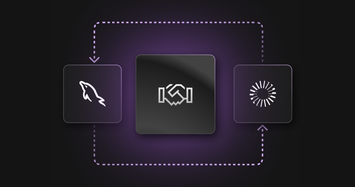LLMs are great at language, not internal company-specific knowledge. Out of the box they don’t know your changelogs, customer tickets, benchmark runs or the breaking API you shipped last week. Traditional databases are optimized for structured data, while AI databases are designed to handle unstructured data like documents and images, which are essential for artificial intelligence applications. That gap shows up as hallucinations, stale answers and hand-wavy explanations your users can’t trust. RAG (retrieval-augmented generation) closes that gap by grounding a model’s output in the right documents at the right time — so responses are traceable, current and specific to your domain.
-for-Real-World-Machine-Learning_feature.png?width=736&disable=upscale&auto=webp)
RAG pairs two stages: retrieve relevant context from a knowledge source (typically a vector store) and generate an answer with the LLM using that context. Those vectors come from running your documents and the user’s query, through an embedding model, which turns text into dense numeric representations so semantically similar items sit near each other in vector space.. Done well, it reduces hallucinations and boosts fidelity by injecting fresh, enterprise-specific facts into prompts instead of relying on the model’s frozen pretraining.
RAG tutorial: A beginner’s guide to retrieval-augmented generation
Read this if you want a conceptual foundation.
The tutorial introduces RAG’s purpose — mitigating hallucinations by grounding outputs — and explains how to convert documents into embeddings, store them in a vector database and use similarity search to fetch context before generation. It also clarifies the roles of the three stages (retrieve, augment, generate) and why vector stores are the right format for semantic lookups instead of brittle keyword matching. See:A Beginner’s Guide to Retrieval-Augmented Generation.
You’ll get a clean mental model for how RAG components fit together and what it means to “inject” up-to-date data into an LLM pipeline, plus the practical reminder that retrieval quality (chunking, embedding choice and query strategy) largely determines answer quality.
Build a RAG knowledge base in Python with LangChain
Read this if you want an end-to-end Python build you can deploy quickly.
This post walks through a support-focused RAG system using LangChain for orchestration, OpenAI for generation and SingleStore as a high-performance vector store. It covers environment setup, ingesting PDFs/help articles, embedding, retrieval and a reusable Python module that queries SingleStore then crafts customer-ready answers. The article discusses why this beats static FAQ bots (dynamic, broader coverage, grounded answers) and cites real-world impact — for example, a LinkedIn case study reporting materially lower resolution time after deploying RAG.
See:How to Build a RAG Knowledge Base in Python with LangChain, OpenAI and SingleStore.
You’ll get concrete patterns (PDF ingestion, document chunking, embedding and query flow) and a rationale for using SingleStore as the vector backend to keep retrieval latency low at scale — so agents pull relevant snippets in milliseconds rather than digging through docs.
Real-time RAG with SingleStore + Vercel: LLM recommender built on streaming data
Read this if freshness and streaming matter to your app.
This build demonstrates “live RAG”: keeping the knowledge base continuously up-to-date and queryable with SingleStore Notebooks and the Job Service, then serving a production app on Vercel. The example app recommends LLMs based on the latest datasets, benchmarks and social sentiment (e.g., Twitter/Reddit), all stored and retrieved from a SingleStore free starter workspace that unifies vectors, full-text, analytics and transactions in one place. Code and steps are linked from the post.
See:Real-Time RAG Application for Free with SingleStore and Vercel.
The architecture shows how to operationalize freshness: stream in new signals, embed them and make them immediately searchable without shuffling data across systems — crucial if your recommendations or answers depend on what happened minutes ago, not last week.
Agentic RAG with SingleStore: Unified SQL + vector search for smarter retrieval
Read this if you’re exploring tool-using agents and multi-step reasoning.
Agentic RAG adds decision-making agents that choose retrieval strategies and compose unified queries that blend relational filters with vector similarity — in the same database. The post shows how SingleStore’s integrated vector search lets you index embeddings (ANN), run vector range/nearest-neighbor search and combine the results with traditional SQL predicates and full-text — ideal for hybrid search and complex constraints.
See:Agentic RAG with SingleStore.
When agents can call one engine that speaks both SQL and vectors, you cut orchestration overhead, eliminate cross-store joins and lower tail latency for compound queries (e.g., “find semantically similar docs from last 30 days, filter by product=‘X’, then rank by recency”).
Which post should you start with?
New to RAG concepts? Start with the Beginner’s Guide to RAG for terminology and the core loop.
Need a practical Python build for support teams? Jump to the Python knowledge base walkthrough.
Your answers must reflect “what’s happening now”? Study the real-time RAG with Vercel architecture.
Designing tool-using agents or hybrid search? Read Agentic RAG with SingleStore.
Implementation notes for RAG
Treat retrieval quality as a first-class concern: choose an embedding model appropriate to your domain, chunk documents with structure in mind and validate recall/precision with offline and in-the-loop evals. Keep your index fresh — stream updates, re-embed when schemas or formats change and log the full retrieval context for observability and audits. When your queries combine semantics with business filters, prefer a platform that handles vectors + SQL + full-text natively to minimize hops and reduce tail latency.
Frequently Asked Questions











.jpg?width=24&disable=upscale&auto=webp)

